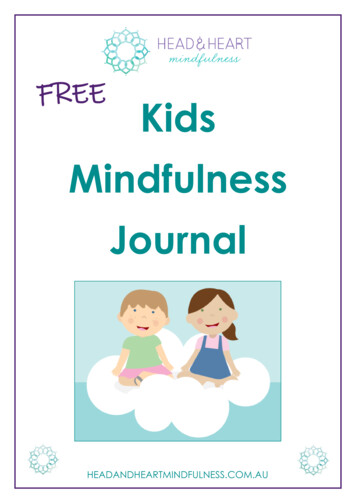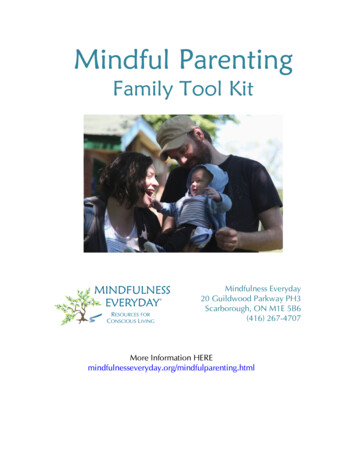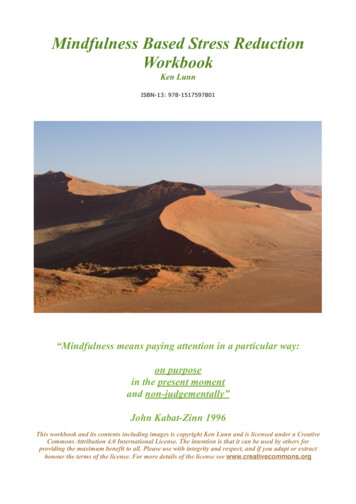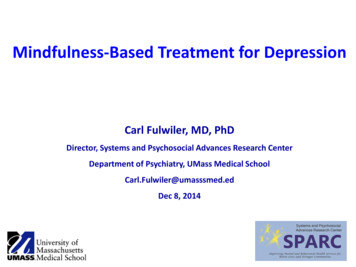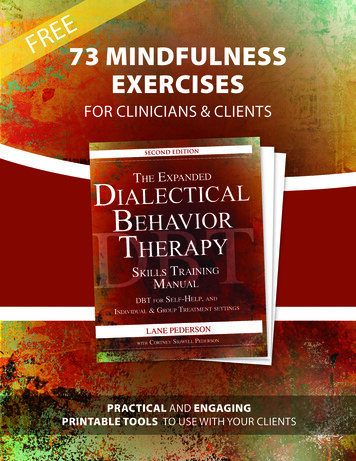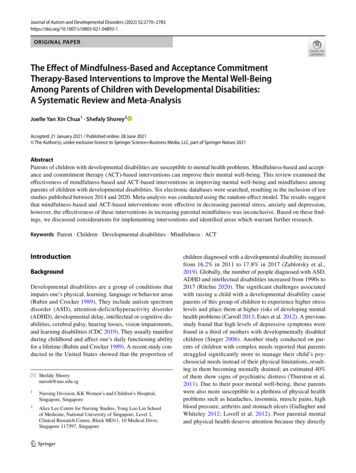
Transcription
Journal of Autism and Developmental Disorders (2022) 4893-1ORIGINAL PAPERThe Effect of Mindfulness‑Based and Acceptance CommitmentTherapy‑Based Interventions to Improve the Mental Well‑BeingAmong Parents of Children with Developmental Disabilities:A Systematic Review and Meta‑AnalysisJoelle Yan Xin Chua1 · Shefaly Shorey2Accepted: 21 January 2021 / Published online: 28 June 2021 The Author(s), under exclusive licence to Springer Science Business Media, LLC, part of Springer Nature 2021AbstractParents of children with developmental disabilities are susceptible to mental health problems. Mindfulness-based and acceptance and commitment therapy (ACT)-based interventions can improve their mental well-being. This review examined theeffectiveness of mindfulness-based and ACT-based interventions in improving mental well-being and mindfulness amongparents of children with developmental disabilities. Six electronic databases were searched, resulting in the inclusion of tenstudies published between 2014 and 2020. Meta-analysis was conducted using the random-effect model. The results suggestthat mindfulness-based and ACT-based interventions were effective in decreasing parental stress, anxiety and depression,however, the effectiveness of these interventions in increasing parental mindfulness was inconclusive. Based on these findings, we discussed considerations for implementing interventions and identified areas which warrant further research.Keywords Parent · Children · Developmental disabilities · Mindfulness · ACT IntroductionBackgroundDevelopmental disabilities are a group of conditions thatimpairs one’s physical, learning, language or behavior areas(Rubin and Crocker 1989). They include autism spectrumdisorder (ASD), attention-deficit/hyperactivity disorder(ADHD), developmental delay, intellectual or cognitive disabilities, cerebral palsy, hearing losses, vision impairments,and learning disabilities (CDC 2019). They usually manifestduring childhood and affect one’s daily functioning abilityfor a lifetime (Rubin and Crocker 1989). A recent study conducted in the United States showed that the proportion of* Shefaly Shoreynurssh@nus.edu.sg1Nursing Division, KK Women’s and Children’s Hospital,Singapore, Singapore2Alice Lee Centre for Nursing Studies, Yong Loo Lin Schoolof Medicine, National University of Singapore, Level 2,Clinical Research Centre, Block MD11, 10 Medical Drive,Singapore 117597, Singapore13Vol:.(1234567890)children diagnosed with a developmental disability increasedfrom 16.2% in 2011 to 17.8% in 2017 (Zablotsky et al.,2019). Globally, the number of people diagnosed with ASD,ADHD and intellectual disabilities increased from 1990s to2017 (Ritchie 2020). The significant challenges associatedwith raising a child with a developmental disability causeparents of this group of children to experience higher stresslevels and place them at higher risks of developing mentalhealth problems (Carroll 2013; Estes et al. 2012). A previousstudy found that high levels of depressive symptoms werefound in a third of mothers with developmentally disabledchildren (Singer 2006). Another study conducted on parents of children with complex needs reported that parentsstruggled significantly more to manage their child’s psychosocial needs instead of their physical limitations, resulting in them becoming mentally drained; an estimated 40%of them show signs of psychiatric distress (Thurston et al.2011). Due to their poor mental well-being, these parentswere also more susceptible to a plethora of physical healthproblems such as headaches, insomnia, muscle pains, highblood pressure, arthritis and stomach ulcers (Gallagher andWhiteley 2012; Lovell et al. 2012). Poor parental mentaland physical health deserve attention because they directly
Journal of Autism and Developmental Disorders (2022) 52:2770–2783affect children’s health outcomes (Karazsia and Wildman2009). For instance, children of depressed parents are proneto developing depression themselves and the estimated ratesof depression among children of depressed parents rangefrom 20 to 40% (Goodman 2007). Therefore, there is a needto develop and implement interventions that promote mentalwell-being among parents of children with developmentaldisabilities.The first step to improving one’s mental well-being isdecreasing one’s stress level (Baum and Posluszny 1999).Stress can be defined as the experience of negative emotions brought about by various physiological, biochemical,cognitive and behavioral changes faced in life (Baum 1990).Chronic stress has shown to result in psychiatric distress, inthe forms of anxiety disorders and major depressive disorders (Khan and Khan 2017). Therefore, addressing stressearly is of paramount importance, especially for parents ofchildren with developmental disabilities, who are prone tohigh stress levels. Psychoeducation and cognitive behavioral therapy (CBT) interventions have a longstanding history in stress management. They aim to teach one how toidentify his or her source of stress and reduce it. However,evidence has suggested that these methods are not appropriate for reducing the stress of those caring for people withdevelopmental disabilities and can increase their stress levelsinstead (Devereux et al. 2009; Noone and Hastings 2010).For instance, some parents of children with developmentaldisabilities who underwent CBT, reported that their dailyconcerns were dismissed and termed as ‘invalid’, henceadding to their frustrations (Singer et al. 2007). In recentyears, researchers have explored the use of mindfulnessbased interventions to manage the stress of these parents byeducating them to accept their stress instead of removing orcontrolling their stressors (Lindahl 2015).Mindfulness can be defined as the state of consciousnessthat one achieves by purposefully paying attention in eachpresent moment in a non-judgmental manner (Kabat‐Zinn2003). Practicing mindfulness can improve one’s attentionand tolerance for unpleasant thoughts and emotions, henceallowing one to cope with life stressors better (Baer 2003).Mindfulness-based interventions include Mindfulness-BasedStress Reduction (MBSR) (Kabat-Zinn 1990), MindfulnessBased Cognitive Therapy (MBCT) (Teasdale et al. 1995) andAcceptance and Commitment Therapy (ACT) (Hayes et al.1999). MBSR focuses on helping participants to enhancetheir awareness of the present moment as they undergoguided mindfulness practices that cover many aspects ofdaily life such as breathing, bodily sensations, movementand eating (Semple and Hatt 2012). It aims to increase one’sgeneral well-being by relieving one’s stress and anxietythat accompanies daily life and chronic illness (Praissman2008). MBCT combines the mindfulness practices of MBSRwith the principles of CBT (Segal and Williams 2001). In2771addition to helping participants develop a heightened awareness of themselves, MBCT teaches participants to view theirpersonal negative ruminative thoughts and feelings as transient events of their mind rather than unchangeable truths. Italso teaches participants to identity their negative thoughtsearly and disengage from them to prevent themselves fromentering a depressive cycle. MBCT was primarily developedto treat clinically depressed patients (Semple and Hatt 2012).On the other hand, ACT combines mindfulness principleswith acceptance and behavioral therapies (Hayes and Strosahl 2004). It utilizes the principle of mindfulness to getparticipants to attain the awareness of their thoughts in thepresent moment and emotions before teaching them ways toaccept and detach from them (Noone and Hastings 2010).ACT also focuses on helping participants to develop psychological flexibility, identify personal values and commitmentto make changes (Hayes et al. 1999).Both mindfulness-based and ACT-based interventionshave shown promising results in reducing stress, depressionand anxiety across different populations such as pregnantmothers, students and parents of children with special needs(Fung et al. 2018; Petcharat and Liehr 2017; Zhang et al.2015). This demonstrates their ability to help improve thewellbeing of parents with children who have developmentdisability. Duncan and colleagues theorized that when parents become more mindful, their mental well-being as wellas their parenting skills will improve (Duncan et al. 2009).Being more mindful will allow them to have greater emotional awareness and self-regulation, hence improving theirmental health. Moreover, learning to view themselves andothers in a compassionate and non-judgmental manner willgreatly improve their interactions with their children (Duncan et al. 2009). Therefore, mindfulness-based and ACTbased interventions for parents with children with developmental disabilities warrant more scrutiny.Current LiteratureThere is limited literature that examined the effectiveness ofmindfulness and ACT-based interventions on parental mentalwell-being. In addition, there are methodological flaws in theavailable literature. To date, five systematic reviews examinedthe effectiveness of mindfulness-based interventions (Burgdorfet al. 2019; Hartley et al. 2019; Rayan and Ahmad 2018; Sohmaran and Shorey 2019; Townshend et al. 2016), one systematic review examined the effectiveness of ACT-based interventions (Byrne et al. 2020) and one systematic review examinedthe effectiveness of both mindfulness-based and ACT-basedinterventions (Osborn et al. 2020) on the mental well-being ofparents. The focus of these reviews were either very narrow,that is, only involving parents of children with ASD (Hartleyet al. 2019), or too broad when parents of children from thegeneral population who do not have any clinical conditions13
2772as well as children with clinical diagnoses such as depression and developmental disabilities were engaged (Burgdorfet al. 2019; Byrne et al. 2020; Townshend et al. 2016). Threereviews focused on parents of children with developmentaldisabilities (Osborn et al. 2020; Rayan and Ahmad 2018; Sohmaran and Shorey 2019), while two other reviews conductedsecondary analyses on the well-being of parents with developmentally disabled children (Burgdorf et al. 2019; Byrneet al. 2020). Three reviews analyzed the outcomes of parentalmental well-being and mindfulness but failed to conduct metaanalyses (Byrne et al. 2020; Osborn et al. 2020; Rayan andAhmad, 2018), hence compromising the strength of their findings (Impellizzeri and Bizzini, 2012). Burgdorf et al. (2019)conducted meta-analyses for the parental stress outcome butincluded data from studies without control groups and hencedid not isolate the impact of the independent variable suchas mindfulness-based interventions on parental stress (Hunteret al. 2016). On the other hand, Sohmaran and Shorey (2019)conducted subgroup analysis to analyze the effect of type ofpsychological intervention on parental stress. As there wasonly one study in the mindfulness subgroup, the effectivenessof mindfulness-based interventions on parental stress could notbe determined. Therefore, further rigorous reviews are neededto determine the effectiveness of mindfulness-based and ACTbased interventions on improving mental well-being amongparents of children with developmental disabilities.AimThis review aimed to consolidate evidence on mindfulnessbased and ACT-based interventions with respect to stress(primary outcome), anxiety, depression, and mindfulness(secondary outcomes) among parents of children withdevelopmental disabilities. It was hypothesized that mindfulness-based and ACT-based interventions were effective atdecreasing parental stress, anxiety and depression, in addition to increasing parental mindfulness at immediate postintervention and follow-up time points.MethodsThis systematic review adhered to the Preferred ReportingItems for Systematic Reviews and Meta-Analyses (PRISMA)guidelines (Moher et al. 2009). A protocol can be found onPROSPERO (CRD42020191783).Eligibility CriteriaPopulationParents of children with developmental disabilities wereincluded in this review. In this review, the term ‘parent’applies to the child’s biological or foster parents, guardians,13Journal of Autism and Developmental Disorders (2022) 52:2770–2783or caregivers who cared for the child in a parental capacity.A child is anyone up to 19 years of age as defined by theWorld Health Organization (WHO 2013). Developmentaldisabilities include ASD, ADHD, developmental delays,intellectual or cognitive disabilities, cerebral palsy, hearinglosses, vision impairments and learning disabilities (CDC2019).InterventionStudies that conducted either mindfulness-based or ACTbased interventions or a combination of both that weredelivered to parents of children with developmental disabilities with an aim to improve their mental well-being wereincluded. Interventions that were delivered to either bothparents and children or parents only were included. Studiesthat conducted mindfulness-based and/or ACT-based interventions on children only were excluded. Non-mindfulnessbased and non-ACT-based interventions were also excluded.ComparatorStudies with control groups that underwent no intervention,placebo interventions, standard care, or wait-list controlwere included.OutcomesThe included studies had to measure self-reported parentalstress pre- and post-intervention. Immediate post-intervention levels of parental stress were regarded as the review’sprimary outcome. The secondary outcomes were selfreported parental anxiety, depression and mindfulness, andneed not be measured by all included studies. Any follow-upmeasurements for all outcome measures were regarded assecondary outcomes.Study DesignOnly clinical controlled trials (CCTs), randomized controlled trials (RCTs), and cluster RCTs were included.Language and Publication statusEnglish-only peer-reviewed journal articles or unpublisheddissertations were included. Other forms of grey literature,such as conference proceedings, posters, book reviews,abstracts, and brief summaries, were excluded.Study SelectionThe PRISMA flow diagram guided the study selection process (Moher et al. 2009). Relevant studies were searched
Journal of Autism and Developmental Disorders (2022) 52:2770–2783from six electronic databases (PubMed, Embase, CINAHL,PsycINFO, Web of Science, and ProQuest) from theirrespective inception dates to May 2020. The key searchterms used were variations of (“child” OR “adolescent”OR “teen” OR “youth”) AND (“parent” OR “father” OR“mother” OR “caregiver” OR “guardian”) AND (“mindfulness” OR “acceptance commitment therapy”) AND (“developmental disorder” OR “autism” OR “asd” OR “adhd” OR“cerebral palsy” OR “intellectual disability” OR “hearingdisability” OR “visual disorder” OR “learning disorder”).Variations of (“random” OR “control” OR “assign” OR“allocate” OR “trial” OR “group” OR “volunteer”) wereadded to the search strategy to select for RCTs and CCTs.The reference lists of relevant reviews and included articleswere also examined, and backward searching was conductedto find additional relevant studies. When the full texts ofpotential studies were not available, their authors were contacted to obtain the papers. All search results were exportedto Endnote Version X8 (Clarivate Analytics 2019), wherethey were categorized according to their databases and hadtheir duplicates removed. All studies had their titles andabstracts screened against the eligibility criteria. Then, thefull texts of selected studies were further analyzed to decidetheir inclusion statuses. This study selection process wasconducted independently by two reviewers, and discussionswere held to resolve any discrepancies that arose.Data ExtractionA data extraction form was used to extract pertinent characteristics related to the study’s sample, design, data management, outcomes measured, intervention duration, formatand delivery method. The mean and standard deviation values of the review’s primary and secondary outcomes wereextracted. When these specific values were not provided,existing data were transformed using relevant formulas toobtain the values (Higgins and Green 2011). This processwas performed independently by two reviewers and disagreements were resolved via discussions.Quality AppraisalThe Cochrane’s risk of bias tool was used to evaluate risk ofbias at the study level. Five types of biases in seven domainswere examined: random sequence generation (selectionbias), allocation concealment (selection bias), blinding ofparticipants and personnel (performance bias), blinding ofoutcome assessment (detection bias), incomplete outcomedata (attrition bias), selective reporting (reporting bias),and other sources of bias (Higgins and Green 2011). Eachdomain was graded a ‘low’ or ‘high’ risk depending oneach study’s details and an ‘unclear’ risk was given wheninadequate details were available. Overall bias rating was2773determined by the worst score that each study received forany domain (Kempler et al. 2016). As a minimum of tenstudies in a forest plot was recommended to produce a meaningful funnel plot to analyze publication bias, publicationbias was not assessed in this review because there was noforest plot with at least ten studies (Sterne et al. 2011).The quality of the overall body of evidence at the outcome level was rated as high, moderate, low, or very lowaccording to the GRADE approach. All outcomes wereinitially rated as high quality, but this rating was droppedwhen any of the five following factors were compromised:risk of bias of individual studies, inconsistency, directnessof evidence, precision of effect estimates, and publicationbias (Higgins and Green 2011). All outcomes were ratedseparately using the online GRADEpro software (GRADEpro 2015). Both reviewers conducted the quality appraisalprocess independently and disagreements were resolved viadiscussions.Data SynthesisThe characteristics of the included studies and the interventions were summarized narratively. Meta-analyses were conducted to pool data with the same outcomes using ReviewManager 5.3 (RevMan 5.3, The Nordic Cochrane Centre,The Cochrane Collaboration, Copenhagen, Denmark) underthe random-effect model. As the included studies used different scales to measure each outcome, standardized meandifferences (SMD) and 95% confidence intervals (CI) wereused as the effect measure under the inverse-variance method(Higgins and Green 2011). Effect sizes were defined as verysmall, small, medium, large, very large, and huge accordingto their values of 0.1, 0.2, 0.5, 0.8, 1.2, and 2.0, respectively(Sawilowsky 2009). However, as two distinct outcomes ofmindfulness were reported in the included studies (interpersonal mindfulness in parenting and parental mindfulnessawareness), separate meta-analyses were conducted for each.The heterogeneity of the results was assessed using the I2statistics and Cochran Q chi-squared test. As per Cochranehand book (Higgins and Green 2011), the I 2 values wereinterpreted as low importance ( 40%), moderate (30–60%),substantial (50–90%), and considerable (75–100%). For thechi-squared test, statistically significant heterogeneity wasidentified when its corresponding p-value was less than 0.10(Higgins and Green 2011). Subgroup analyses were conducted to reduce heterogeneity levels and analyze the effectof certain variables on the outcomes investigated (Higginsand Green 2011; Sedgwick 2014). The variables analyzedwere type of intervention, geographical distribution of study,and intervention duration. One study that only used the distress subscale of the Parenting Stress Index–Short Form tomeasure parental stress levels, unlike the other includedstudies that measured total parental stress, was narratively13
2774synthesized (Neece 2014). Hilkey (2019) was also narratively synthesized and it was an unreviewed master’s dissertation with exceptionally low number of participants (threein intervention group; two in control group).ResultsSearch OutcomesA total of 1,753 articles were found from the six listed electronic databases and relevant reference lists. After removing561 duplicates and excluding 1,101 articles based on theirtitles and abstracts, 91 articles were left for full-text screening. The full-text screening excluded another 81 articles,leaving ten relevant articles to be included in this review.Seven were peer-reviewed primary studies (Behbahani et al.2018; Corti et al. 2018; Lo et al. 2017, 2020; Neece 2014;Rayan and Ahmad 2017; Whittingham et al. 2016), whilethree were unpublished dissertations (Hilkey 2019; Petcharat 2018; Zody 2018). Figure 1 details the PRISMA flowdiagram.Characteristics of the Included StudiesThe ten included studies were conducted in seven different countries—Iran (n 1), Jordan (n 1), Hong Kong(n 2), Thailand (n 1), Italy (n 1), Australia (n 1),and the United States of America (n 3)—that collectivelyanalyzed 614 parents of children with developmental disabilities. Seven studies focused on parents of children withspecific conditions—ADHD (n 2), autism or ASD (n 4),and cerebral palsy (n 1)—while three studies recruited parents of children with a mixture of ASD, ADHD, and otherdevelopmental disabilities such as developmental delaysand intellectual disabilities (Lo et al. 2017; Neece 2014;Petcharat 2018). There were seven RCTs and three CCTs.Four studies conducted ACT-based interventions, while therest conducted mindfulness-based interventions (Corti et al.2018; Hilkey 2019; Whittingham et al. 2016; Zody 2018).No study conducted a combination of mindfulness-basedand ACT-based interventions. Nine studies conducted faceto-face group-based interventions that utilized interactiveteaching methods (group discussions, mindfulness exercises, and activity worksheets), with two studies adoptingmixed methods such as phone call consultations in additionto the face-to-face group sessions to deliver the intervention(Rayan and Ahmad 2017; Whittingham et al. 2016). Onestudy designed an interactive online course for its participants to complete the course independently (Hilkey 2019).The summary of included studies is presented in Table 1.13Journal of Autism and Developmental Disorders (2022) 52:2770–2783Quality Appraisal (Study Level)The Cochrane risk of bias tool was used to assess the risksof bias for all included trials. The overall bias was rated asunclear for two studies and high for the remaining studies(Hilkey 2019; Lo et al. 2017). Inter-rater agreement amongboth reviewers was approximately 97%, and the Cohen’skappa value was 0.95. The risk of bias summary is shownin Online Resource 1, Fig. S1.Parental Stress Scores at ImmediatePost‑InterventionA meta-analysis was conducted for the eight studies thatassessed parental stress immediately post-intervention(Behbahani et al. 2018; Corti et al. 2018; Lo et al. 2017,2020; Petcharat 2018; Rayan and Ahmad 2017; Whittinghamet al. 2016; Zody 2018). It showed a statistically significantmedium effect among 563 participants, favoring the intervention group (SMD 0.50, 95% CI: 0.88 to 0.11,Z 2.51, p 0.01), with significant substantial statisticalheterogeneity (I2 77%, p 0.0001) (Fig. 2a).Parental stress was not affected by intervention type andintervention duration as the subgroup analyses for these factors revealed statistically non-significant subgroup differences (p 0.05) (Online Resource 1, Fig. S2.1 and S2.3).A subgroup analysis according to geographical distribution showed statistically significant subgroup differences (I2 91.1%, p 0.0001) and reduced heterogeneity to lowlevels for the Middle Eastern countries subgroup ( I2 12%,p 0.29), the Western countries subgroup ( I 2 22%,p 0.28), and the Asian countries subgroup ( I 2 0%,p 0.48). The Middle Eastern countries subgroup had astatistically significant very large effect, while the Westerncountries subgroup had a statistically significant small effectand the Asian countries subgroup had a statistically nonsignificant very small effect (Online Resource 1, Fig. S2.2).Parental Anxiety Scores at ImmediatePost‑InterventionA meta-analysis was conducted for the four studies thatassessed parental anxiety immediately post-intervention(Petcharat 2018; Rayan and Ahmad 2017; Whittinghamet al. 2016; Zody 2018). It showed a statistically significant medium effect among 185 participants, favoring theintervention group (SMD 0.63, 95% CI: 0.93 to 0.34,Z 4.17, p 0.0001), with low statistical heterogeneity (I2 0%, p 0.52) (Fig. 2b).Parental anxiety was not affected by intervention type,geographical distribution and intervention duration as the
Journal of Autism and Developmental Disorders (2022) 52:2770–2783Fig. 1 PRISMA flow diagramRecords identified through sixelectronic databases(n 1745)IdentificationScreening2775Total number of records(n 1753)Records screened for titles/abstracts(n 1192)EligibilityFull-text articles assessed foreligibility(n 91)IncludedArticles included in the systematicreview (n 10)Studies included in the narrativesynthesis(n 10)Studies included in the metaanalysis(n 8)subgroup analyses for these factors revealed statisticallynon-significant subgroup differences (p 0.05) (OnlineResource 1, Fig. S3.1, S3.2, and S3.3).Parental Depression Scores at ImmediatePost‑InterventionA meta-analysis was conducted for the five studies thatassessed parental depression immediately post-intervention(Lo et al. 2017; Neece 2014; Rayan and Ahmad 2017; Whittingham et al. 2016; Zody 2018). It showed a statisticallysignificant medium effect among 389 participants, favoringAdditional records identifiedthrough other sources(n 8)Number of duplicates removed(n 561)Records excluded based ontitles/abstracts(n 1101)Non-experimentaldesignsIntervention notconducted on parentsDid not meet theinclusion criteriaReasons for excluding full-text articles(n 81)Intervention not conducted on parent(n 4)Intervention not mindfulness-based orACT-based (n 3)Full text unavailable (n 2)Full text not published in English (n 2)Children do not have developmentaldisabilities (n 3)No control group (n 28)Active control group (n 4)Outcome of parental stress notmeasured (n 15)No pre and post test data provided forcontrol and intervention group (n 4)Control group comprised of motherswith normal children (n 1)Children aged 19 years old (n 8)Qualitative study (n 1)Study conducted additional analysisbased on data collected in an includedstudy (n 1)No intervention carried out (n 3)Outcome data cannot be transformed tomean (sd) form (n 1)No control group data reported (n 1)the intervention group (SMD 0.72, 95% CI: 1.34 to 0.10, Z 2.26, p 0.02), with significant substantial toconsiderable statistical heterogeneity (I2 86%, p 0.0001)(Fig. 2c).Parental depression was not affected by intervention typeand intervention duration as the subgroup analyses for thesefactors revealed statistically non-significant subgroup differences (p 0.05) (Online Resource 1, Fig. S4.1 and S4.3).A subgroup analysis according to geographical distribution showed statistically significant subgroup differences (I2 92.6%, p 0.00001) and reduced heterogeneity to lowlevels for the Western countries subgroup (I2 0%, p 0.71),13
2776Journal of Autism and Developmental Disorders (2022) 52:2770–2783Table 1 Summary of the included studiesStudy(Country)Research design Child conditionIntervention delivery methodBehbahani et al. 2018(Iran)2 arm RCT Delivered by: Not stated(Group-based, interactive)Corti et al. 2018(Italy)2 arm CCT Hilkey 2019(USA)2 arm RCT Lo, Chan, Szeto, Chan,& Choi, 2017(Hong Kong)2 arm RCT Lo et al. 2020(Hong Kong)2 arm RCT Neece 2014(USA)2 arm RCT Petcharat 2018(Thailand)2 arm CCT Rayan and Ahmad 2017(Jordan)2 arm CCT Whittingham et al. 2016(Australia)3 arm RCT Zody 2018(USA)2 arm RCT ADHDMindfulness-based Review outcomes:or ssMindfulness-based 1.Yes2.No3.No4.NoACT-based1.YesAutismDelivered by: Cognitive behavior2.Notherapists with expertise in ACT3.Nopractice4.Yes(Group-based, interactive)ACT-based1.YesASDDelivered by: Online module for2.Nomat, no facilitator required3.No(Individual, online interactive4.Nocourse)Mindfulness-based 1.YesASD, ADHD, DD Delivered by: Experienced mind2.Nofulness instructors3.Yes(Group-based, interactive)4.YesADHDDelivered by: Instructors trained by Mindfulness-based 1.Yes2.Nofirst author and external trainer3.No(Group-based, interactive)4.YesMindfulness-based 1.YesASD, DDDelivered by: Experienced mind2.Nofulness instructor3.Yes(Group-based, interactive)4.NoMindfulness-based 1.YesDDDelivered by: Primary researcher2.Yeswho is trained and experienced3.Noin western mindfulness and Thai4.YesBuddhism(Group-based, interactive)Mindfulness-based 1.YesASDDelivered by: Primary researcher2.Yeswho is a3.Yesdoctoral nursing student with4.Yes (no datamasters in psychiatric and mentalreported, nothealth nursing, certified as mindused in review)fulness instructor(Group-based, interactiveIndividual phone calls.)ACT-based1.YesCerebral PalsyDelivered by: Psychologists with2.Yestraining in ACT 3.Yes(Group-based, interactive4.NoIndividual phone calls.)ACT-based1.YesASDDelivered by: Primary researcher2.Yeswho is a masters level clinician3.Yestrained in ACT and parents of4.NoASD children(Group-based, interactive)ACT Acceptance and Commitment Therapy, ADHD Attention deficient/hyperactivity disorder, ASD Autism Spectrum Disorder, CCT ControlledClinical Trial, DD Developmental Delay, RCT Randomized Controlled Trialwhile the Middle Eastern countries subgroup and the Asiancountries subgroup only had one study each hence heterogeneity levels could not be measured. The Western countriessubgroup had a statistically significant medium effect, while13the Middle Eastern countries subgroup had a statisticallysignificant very large effect and the Asian countries subgroup had a statistically non-significant very small effect(Online Resource
Based Cognitive Therapy (MBCT) (Teasdale et al. 1995) and Acceptance and Commitment Therapy (ACT) (Hayes et al. 1999). MBSR focuses on helping participants to enhance their awareness of the present moment as they undergo guided mindfulness practices that cover many aspects of daily life such as breathing, bodily sensations, movement

